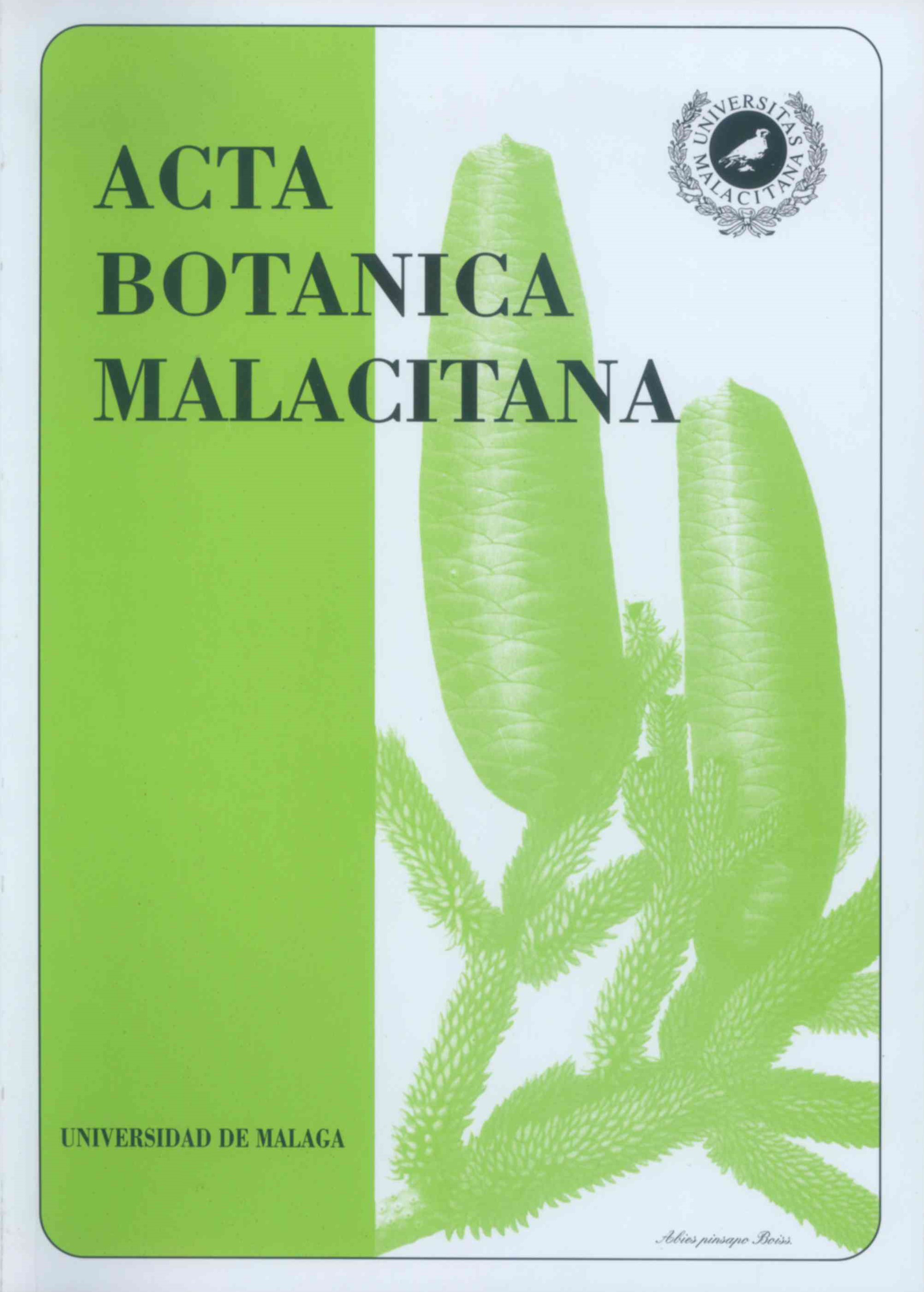The Eucalyptus pollea and its incidence in the atmosphere of Vigo (N. W. Spain)
DOI:
https://doi.org/10.24310/abm.v26i0.7403Keywords:
Meteorology, Myrtaceae, Polllen, Eucalyptus, VigoAbstract
Eucalyptus globulus Labill. is the most frequent arboreal species of the Myrtaceac family in the surroundings of the city of Vigo, and it constitues abundant and dense forestal masses. Although its pollen can be considered as a moderated allergen, in areas in which Eucalyptus was used in extended reafforestations, it can cause allergenic problems. From 1995 to 2000 a Hirst-type volumetric sampler (Hirst, 1952), LANZONI VPPS 2000 placed in the left bank of the Vigo estuary (42°14'15"N, 8°43'30"W) was used for collecting airborne pollen. From year to year important oscillations in the annual total pollen was observed, alternating years of high concentrations with other of lower values. Eucalyptus pollen counts represent a percentage that vary between 1% to 3% of the total pollen, the high quantity being collected in 1997 with 1,147 pollen grains. The Myrtaceae pollen appears in the atmosphere of Vigo all over the year, although the more important concentrations are registered during March and April. Moreover, maximum daily concentrations occur between 17.00 and 18.00 hours. Finally, a statistical analysis has been carried out in order to search for the possible correlations between pollen concentration and the main meteorological parameters. The N-NE wind and relative humidity were the parameters that show the highest correlation coefficients, positive and negative respectively.
Downloads
Metrics
References
AIRA M.J., A. DOPAZO y A. ARGIBAY -1999- Aeropalinología en Galicia: Estación de Santiago de Compostela (1998). Rea 5: 119-112.
ANDERSEN, T. -1991- A model to predict the beginning of the pollen season. Grana 30: 269-275.
ANDERSEN, S. Th. -1980- Influence of climatic variation on pollen season severity in wind- Pollinated trees and herbs. Grana 19: 47-52.
ARENAS, L., C. GONZÁLEZ, J.M. TABARÉS, I. IGLESIAS, M.V. JATO y J. MÉNDEZ -1996- Sensibilización cutánea a pólenes en pacientes afectos de rinoconjuntivitis-asma en la población de Ourense en el año 1994-1995. Proceedings of the Pi European Symposio on Aerobiology, CA'96. Santiago.
BELMONTE, J., J.M. ROURE & X. MARCH - 1998- Aerobiology of Vigo, North-Western Spain: Atmospheric pollen spectrum and annual dynamics of the most important taxa, and their clinical importance for allergy. Aerobiologia 14: 155-162.
BELMONTE, J., M. VENDRELL y J.M. ROURE - 1999- Aerobiología en Cataluña: estación de Barcelona (1999). Rea 5: 79-82.
BERMÚDEZ, J. y M. TOUZA -2000- Las cifras del tercer inventario forestal en Galicia y su incidencia en la industria de la transformación de la madera. Cis-Madera 2000, 4: 6-24.
CARBALLEIRA, A., C. DEVESA, R. RETUERTO, E. SANTILLÁN y E. UCIEDA -1983- Bioclimatologia de Galicia. Fund. Bardé de la Maza, La Coruña: 391.
DAHL, A. & STRANDHEDE, S. -1996- Predicting the intensity of the birch pollen season. Aerobiología, 12: 97-106.
DE LA LAMA, G. -1978- Atlas del eucalipto. Instituto Nacional de investigaciones Agrarias, Ministerio de Agricultura (TOMO V). Madrid.
DOMÍNGUEZ, E., J.L. UBERA y C. GALÁN - 1984- Polen alergógeno de Córdoba. Publicaciones del Monte de Piedad y Caja de Ahorros de Ronda. Córdoba.
DOMÍNGUEZ, E., C. GALÁN, F.E. VILLAMANDOS & F. INFANTE -1992- Handling and evaluation of the data from the aerobiological sampling. Monografías Rea-Ean 1: 1-18.
EL-GHAZALY, G., P. EL-GHAZALY, K. LARSSON & S. NILSON -1993- Comparison of airborne pollen grains in Huddinge and Stockholm, Sweden. Aerobiologia 9: 53-67.
EMBERLIN, J., M. SAVAGE & R. WOODMAN - 1993- Annual variations in the concentrations of Betula pollen in the London area, 1961-1990. Grana, 29: 301-309.
GALÁN, C., R. TORMO, J. CUEVAS, F. INFANTE & E. DOMÍNGUEZ -1991- Theoretical daily variation patterns of airborne pollen in the South-west of Spain. Grana 30: 201-209.
GÓNZALEZ, F.J., J. MORALES, P. CANDAU, C. TOMÁS y A.M. PÉREZ TELLO -1999- Aerobiología en Andalucía: estación de Sevilla (1998). Rea 4: 49-52.
HIRST, J.M. -1952-An automatic volumetric sporetrap. Ann. App!. Biol. 36: 257-265.
JAGER, S., F.TH. SPIEKSMA & N. NOLARD - 1991- Fluctuations and trends in airborne concentrations of some abundant pollen types, monitored at Vienna, Leiden and Brussels. Grana 30: 309-312.
LATORRE, F. -1999- Differences between airborne pollen and flowering phenology of urban trees with reference to production, dispersal and interannual climate variability. Aerobiologia 15: 131-141.
LEWIS, W.H., P. V1NAY & V.E. ZENGER -1983- Airborne and allergenic pollen of North America. The Johns Hopkins Univers. Press. 254. Baltimore.
NILSSON, S. & S. PERSSON -1981- Tree pollen spectra in the Stockholm region (Sweden), 1973- 1980. Grana 20: 179-182.
RECIO, M. -1995- Análisis polínico de la atmósfera de Málaga (1991-1994). Relación con los parámetros meteorológicos. Tesis Doctoral. Universidad de Málaga.
RODRÍGUEZ-RAJO, Fi. -2000- El polen como fuente de contaminación ambiental en la ciudad de Vigo. Tesis Doctoral. Universidad de Vigo.
SP1EKSMA, F. TH., N. NOLARD, G. FRENGUELLI & D. VAN MOERBEKE -1993- Polen atmosférico en Europa. UCB, Bruselas.
SPIEKSMA, F. TH., J.C. EMBERLIN, M. HJELMROOS, S. JAGER & R.M. LEUSCHNER -1995- Atmospheric birch (Bctula) pollen in Europe: Trends and fluctuations in annual quantities and the starting dates of the seasons. Grana 34: 51-57.
SUBIZA, J., JEREZ, M., JIMÉNEZ, JA., NARGANES, J.M., CABRERA, M., V ARELA, S. & SUBIZA, E. -1995- Allergenic pollen pollinosis in Madrid. J. Allergy Clin. lmmunol., 96: 15-23.
TRIGO, MM., M. RECIO, F.J. TORO Y B. CABEZUDO-1998- Aerobiologra de Andalucía: estación de Málaga. (1995-1998). Rea 3:33-36.
VALDÉS, B., M.J. DÍEZ e I. FERNÁNDEZ, (eds.) -1987- Atlas polínico de Andalucía Occidental. Inst. de desarrollo Regional de la Universidad de Sevilla. Excma. Diputación de Cádiz. Sevilla.
Downloads
Published
How to Cite
Issue
Section
License
Copyright (c) 2019 Acta Botanica Malacitana

This work is licensed under a Creative Commons Attribution-NonCommercial-ShareAlike 4.0 International License.
All information related to the licensing of published works in Acta Botanica Malacitana and copyright can be found in our Editorial Policy.







1.png)
